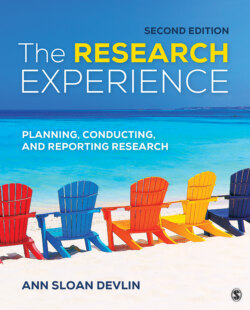Читать книгу The Research Experience - Ann Sloan Devlin - Страница 30
Theories: What They Are and Why They Matter
ОглавлениеThe chapter has devoted quite a bit of space to a description of how information can be packaged in manageable ways to support the research process. There are three important terms that reflect different kinds of “packaging”: hypotheses, theories, and laws. In The Dictionary of Psychology (Corsini, 2002), a hypothesis is defined as “a testable proposition based on theory, stating an expected empirical outcome resulting from specific observable conditions” (p. 463). This dictionary defines a theory as “a body of interrelated principles and hypotheses that explain or predict a group of phenomena and have been largely verified by facts or data” (p. 994). A law is defined in this dictionary as “a theory accepted as correct, that has no significant rivals in accounting for the facts within its domain” (p. 536). Thus, a theory is the pivotal link between hypotheses, which are generated from theories at the least-verified end of the spectrum, and laws, on the other end of the spectrum, which emerge when a theory is viewed as having been consistently verified and operates without challenge (Figure 1.6).
Theory: “A body of interrelated principles and hypotheses that explain or predict a group of phenomena and have been largely verified by facts or data” (Corsini, 2002, p. 994).
Law: “A theory accepted as correct, that has no significant rivals in accounting for the facts within its domain” (Corsini, 2002, p. 536).
A question you might ask is whether the social and behavioral sciences have any laws. Three-and-a-half pages of laws are listed in Corsini’s (2002) dictionary, including the law of association, the law of belongingness, the law of common fate, the law of effect, the law of mass action, the law of proximity, and the law of vividness (pp. 537–540). These “laws” may conform to the idea of a theory being accepted as correct and lacking significant rivals, but many social scientists might have some difficulty easily coming up with an example of a “law” in their discipline. In contrast, we could all probably think of some of the laws of thermodynamics from high school; at the very least, we would know that there were laws of thermodynamics. Many of us think of laws as those referred to as natural laws, in terms of aspects of nature that predictably occur under specific conditions.
As is evident in that description, one challenge in the social and behavioral sciences is that human behavior doesn’t conform to this idea of invariable occurrence. As a result, in research, we spend most of our time testing hypotheses; if we are fortunate, these hypotheses are generated within the context of a theory. Thus, hypotheses and theories and their interrelationships are important to understand.
Let’s further consider the importance of theories. One of the fundamental goals of research is to provide information that allows us to predict what will happen in future situations without having to retest the assumptions. For example, it would be useful to know whether a given antibiotic, such as penicillin, works on a variety of bacteria, and not just one type. Perhaps you remember taking amoxicillin, a type of penicillin, for childhood ear infections. Amoxicillin, sometimes described as a broad-spectrum antibiotic, has been demonstrated to be effective in treating tonsillitis, bronchitis, and pneumonia, among other bacterial infections. Thus, scientists could claim the effectiveness of this drug over a range of situations; it has generality.
One common definition of research is systematic investigation with the goal of generalizable knowledge. This definition comes from the federal regulations known as the revised Common Rule that most institutions follow to regulate how research is conducted (this rule is discussed in Chapter 4 of this book). Generalizable knowledge refers to the idea that the knowledge gained from research applies beyond the circumstances and characteristics of the particular investigation (i.e., we should be able to infer what will happen beyond the circumstances at hand).
Figure 1.6 Venn Diagram of Link Between Law, Theory, and Hypothesis
How does this idea of generalizability relate to theory? At its core, a theory provides an interrelated set of principles demonstrated to explain not just the situation in question but a group of phenomena. Such principles have been tested and verified. Without theories, we would continually examine situations as if they were unique, without appreciating what they have in common with other presumably related situations. We would not be in a position to predict behavior; we would not appreciate how the variables under examination are related to each other; and we would have a difficult time developing a comprehensive understanding of human behavior.
In the social and behavioral sciences, theories use interrelated concepts to describe and predict behaviors (events) by making clear the relationships among variables. In Ulrich’s (1991) Theory of Supportive Design, his explanatory framework, he offers three dimensions predicted to enhance patients’ well-being in health care settings. These dimensions are (1) positive distraction, (2) social support, and (3) perceived control. Having (1) positive aspects of the environment (e.g., artwork, a view to nature, or music) to distract us from our worries; (2) the social contact of others, either in person (accommodated by seating) or by phone, e-mail, or Skype; and (3) the ability to control aspects of the environment around us, for example, by using the remote control or adjusting the temperature, is theorized to lead to greater well-being. These three constructs have in common their focus on the physical environment, on the one hand, and their predicted effect on human well-being, on the other. Could we imagine generating hypotheses within this theoretical framework? Before answering that question, let’s revisit the concept of a hypothesis, which is based on a theory, is testable, and states an expected empirical outcome based on observable data.
